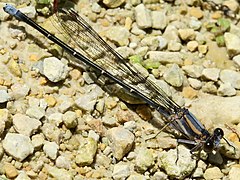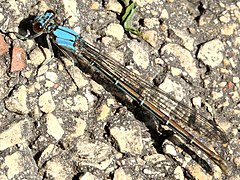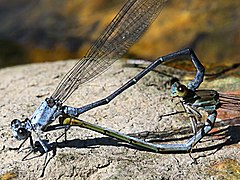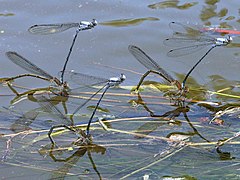
Damselflies are flying insects of the suborder Zygoptera in the order Odonata. They are similar to dragonflies but are smaller and have slimmer bodies. Most species fold the wings along the body when at rest, unlike dragonflies which hold the wings flat and away from the body. Damselflies have existed since the Jurassic, and are found on every continent except Antarctica.

The red-veined darter or nomad is a dragonfly of the genus Sympetrum.

The common darter is a dragonfly of the family Libellulidae native to Eurasia. It is one of the most common dragonflies in Europe, occurring in a wide variety of water bodies, though with a preference for breeding in still water such as ponds and lakes. In the south of its range adults are on the wing all year round.

The blue-tailed damselfly or common bluetail is a damselfly, belonging to the family Coenagrionidae.

Argia is a genus of damselflies of the family Coenagrionidae and of the subfamily Argiinae. It is a diverse genus which contains about 114 species and many more to be described. It is also the largest genus in Argiinae. They are found in the Western Hemisphere. They are commonly known as dancers. Although the genus name comes from Ancient Greek: ἀργία, romanized: argia, lit. 'laziness', dancers are quite active and alert damselflies. The bluer Argia species may be confused with Enallagma species.

The Aztec dancer damselfly is one of the pond damsels. Common name originates from the Aztecs, and scientific names comes from the Nahuas.
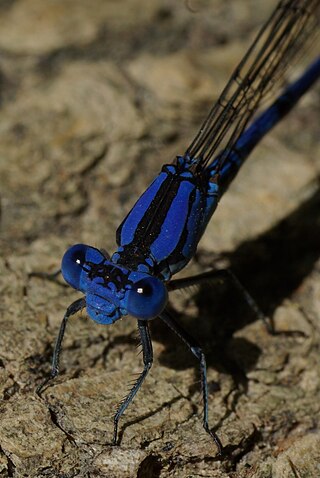
The springwater dancer is a damselfly of the family Coenagrionidae.

The American rubyspot is a damselfly of the family Calopterygidae. Males have a lustrous red head and thorax. The abdomen of both genders is brilliant green. The female may have either green or copper colored marks on the thorax.

Eastern forktail is a member of the damselfly family Coenagrionidae.

Lestes praemorsus is a damselfly species in the family Lestidae. It is commonly known as the scalloped spreadwing or sapphire-eyed spreadwing. It is very widely distributed from India to China and south to New Guinea.

Chalcolestes viridis, formerly Lestes viridis, is a damselfly of the family Lestidae. It has a metallic green body and at rest it holds its wings away from its body. Its common name is the willow emerald damselfly, the green emerald damselfly, or the western willow spreadwing. It has an elongated abdomen and pale brown spots on its wings and resides in areas of still water with overhanging trees.

Orthetrum triangulare is an Asian freshwater dragonfly species. The common name for this species is blue-tailed forest hawk. Two subspecies of Orthetrum triangulare are currently recognised, the nominate subspecies and O. t. malaccense.

Agriocnemis pygmaea is a species of damselfly in the family Coenagrionidae. It is also known as wandering midget, pygmy dartlet or wandering wisp. It is well distributed across Asia and parts of Australia.

Pseudagrion malabaricum, Malabar sprite, jungle grass dart, is a species of damselfly in the family Coenagrionidae. It is found in India, Sri Lanka, and Myanmar.

Anax indicus is a species of dragonfly in the family Aeshnidae. It is found in India, Nepal, Pakistan, Sri Lanka, and Thailand.

The blue-fronted dancer is a species of damselfly in the family Coenagrionidae, native to parts of North America. It was first described by the American zoologist Thomas Say in 1840. It is a common species with a wide range and the International Union for Conservation of Nature has assessed its conservation status as being of "least concern".

The blue corporal, also known as little corporal, is a dragonfly in the Libellulidae, or skimmer family. First described as Libellula deplanata by Jules Pierre Rambur in 1842, it is common across much of the eastern United States.

Elattoneura tetrica, the black and yellow bambootail, is a damselfly species in the family Platycnemididae. It is endemic to Western Ghats in India.

Lestes dorothea, the forest spreadwing, is a damselfly species in the family Lestidae. It is distributed from south and northeast India to Thailand and Malaysia.

Argia vivida, the vivid dancer, is a species of narrow-winged damselfly in the family Coenagrionidae. This species is commonly found in springs and forests Central America and North America. Argia vivida inhabit areas of diverse temperatures due to thermoregulation. The species is also considered the state insect of Nevada.





